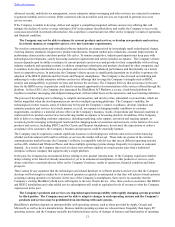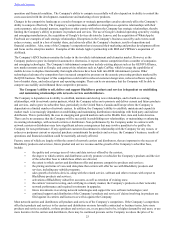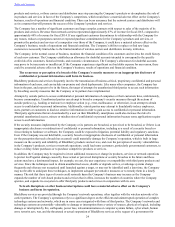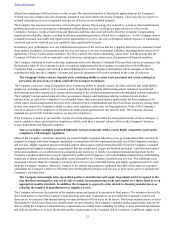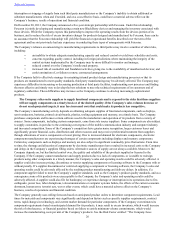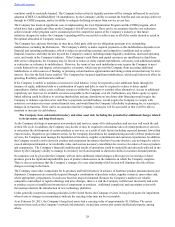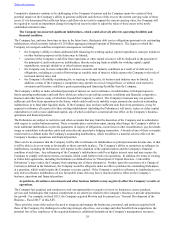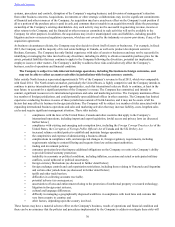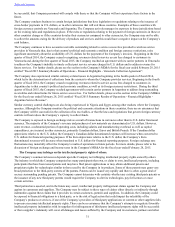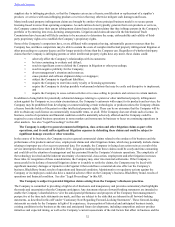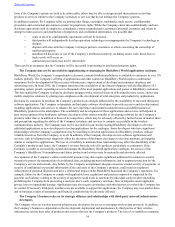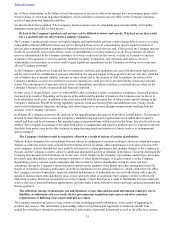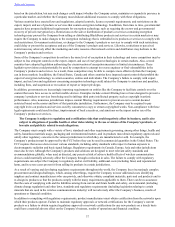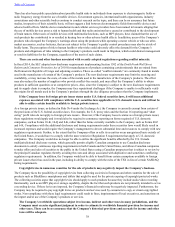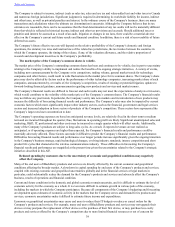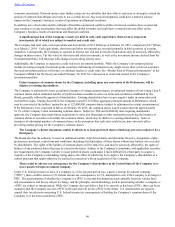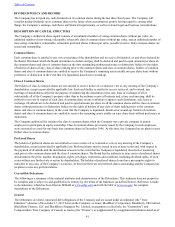Blackberry 2015 Annual Report Download - page 40
Download and view the complete annual report
Please find page 40 of the 2015 Blackberry annual report below. You can navigate through the pages in the report by either clicking on the pages listed below, or by using the keyword search tool below to find specific information within the annual report.
Table of Contents
31
be successful, that Company personnel will comply with them, or that the Company will not experience these factors in the
future.
The Company conducts business in certain foreign jurisdictions that have legislation or regulations relating to the issuance of
cross-border payments in U.S. dollars, or in other currencies that will exit those countries. Examples of these countries with
foreign currency controls are Venezuela and Argentina. The Company actively manages its exposure in these jurisdictions based
on the existing rules and regulations in place. If the rules or regulations relating to the payment of foreign currencies in these or
other countries change or if the countries devalue their currencies compared to other currencies, the Company may not be able
to collect the amounts owing for the delivery of products and services and this would have a negative impact on the Company’s
cash balance.
The Company continues to have accounts receivable outstanding related to service access fees provided to wireless service
providers in Venezuela that, due to that country's political and economic condition and foreign currency restrictions, raise
significant uncertainty about the availability of U.S. dollars for the payment of the Company’s invoices. Beginning in the first
quarter of fiscal 2014, the Company ceased recognizing revenues related to service access fees charged to customers in
Venezuela and, during the first quarter of fiscal 2015, the Company reached an agreement with its carrier partners in Venezuela
to address the Company's inability to timely collect past service revenue charged in U.S. dollars and to address revenue for
future services. For further details, please see the section in the Company's MD&A for the fiscal year ended February 28, 2015
entitled “Fiscal 2015 Summary Results of Operations - Financial Highlights - Venezuela Collection Agreement”.
The Company also experienced similar currency-related issues in Argentina beginning in the fourth quarter of fiscal 2014,
which led to the deterioration of collections from the carriers to whom the Company provides services. Beginning in the fourth
quarter of fiscal 2014, the Company ceased recognizing revenues related to service access fees charged to customers in
Argentina due to that country's political and economic condition, as well as its foreign currency restrictions. During the third
quarter of fiscal 2015, the Company reached agreements with certain carrier partners in Argentina to address long outstanding
receivables and related terms for future service access fees. For further details, please see the section in the Company's MD&A
for the fiscal year ended February 28, 2015 entitled “Fiscal 2015 Summary Results of Operations - Financial Highlights -
Argentina Service Revenue”.
Similar currency control challenges are also being experienced in Nigeria and Egypt, among other markets where the Company
operates. Although the Company monitors the political and economic situations in these countries, there are no assurances that
the Company will be successful in the collection of its receivables, or that the laws and regulations that govern foreign currency
controls will not reduce the Company’s capacity to collect funds.
The Company is exposed to foreign exchange risk as a result of transactions in currencies other than its U.S. dollar functional
currency. The majority of the Company’s revenue and purchases of raw materials are denominated in U.S. dollars. However,
some revenue, a substantial portion of operating costs, including salaries and manufacturing overhead, as well as capital
expenditures, are incurred in other currencies, primarily Canadian dollars, Euros and British Pounds. If the Canadian dollar
appreciates relative to the U.S. dollar, the Company’s Canadian dollar denominated expenses will increase when converted to
U.S. dollars for financial reporting purposes. If the Euro depreciates relative to the U.S. dollar, the Company’s Euro
denominated revenues will decrease when translated to U.S. dollars for financial reporting purposes. Foreign exchange rate
fluctuations may materially affect the Company’s results of operations in future periods. For more details, please refer to the
discussion of foreign exchange and income taxes in the Company's MD&A for the fiscal year ended February 28, 2015.
The Company may infringe on the intellectual property rights of others.
The Company’s commercial success depends upon the Company not infringing intellectual property rights owned by others.
The industry in which the Company competes has many participants that own, or claim to own, intellectual property, including
participants that have been issued patents and may have filed patent applications or may obtain additional patents and
proprietary rights for technologies similar to those used by the Company in its products. Some of these patents may grant very
broad protection to the third-party owners of the patents. Patents can be issued very rapidly and there is often a great deal of
secrecy surrounding pending patents. The Company cannot determine with certainty whether any existing third-party patents or
the issuance of any new third-party patents would require the Company to alter its technologies, pay for licenses or cease
certain activities.
Third parties have asserted, and in the future may assert, intellectual property infringement claims against the Company and
against its customers and suppliers. The Company may be subject to these types of claims either directly or indirectly through
indemnities against these claims that it provides to certain customers, partners and suppliers. In addition, the Company could
be exposed to financial obligations to a third party, or to the risk of legal action that could impact the saleability of the
Company’s products or services, if one of the Company’s providers of third-party applications or content or other suppliers fails
to procure necessary intellectual property rights. There can be no assurance that the Company’s attempts to negotiate favorable
intellectual property indemnities with its suppliers for infringement of third-party intellectual property rights will be successful
or that a supplier’s indemnity will cover all damages and losses suffered by the Company and its customers, partners and other


